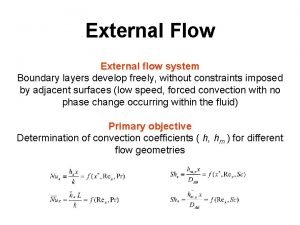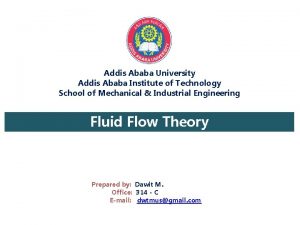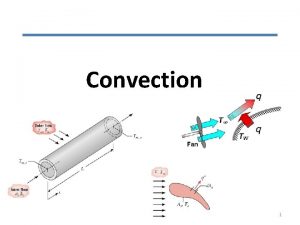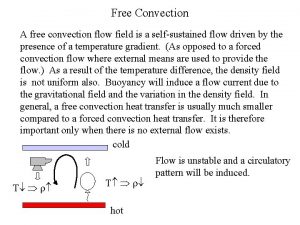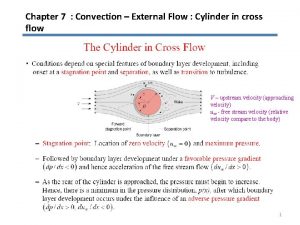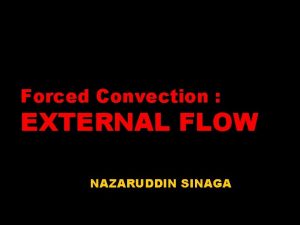Chapter 7 Convection External Flow 7 1 7











- Slides: 11

Chapter 7 Convection: External Flow (7. 1 -7. 5) External Flow 1

Introduction In Chapter 6 we obtained a non-dimensional form for the heat transfer coefficient, applicable for problems involving the formation of a boundary layer: • In this chapter we will obtain convection coefficients for different flow geometries, involving external flows: – Flat plates – Spheres, cylinders, airfoils, blades Ø In such flows, boundary layers develop freely • Two approaches: – Experimental or empirical: Experimental heat transfer measurements are correlated in terms of dimensionless parameters – Theoretical approach: Solution of boundary layer equations. External Flow 2

Flat Plate in Parallel Flow Ø For Laminar Flow: (7. 1 a) (7. 1 b) Ø For Turbulent Flow: (7. 2 a) (7. 2 b) Ø Fluid properties are usually evaluated at the film temperature: (7. 3) External Flow 3

Example 7. 1 Air at a pressure of 6 k. N/m 2 and a temperature of 300 o. C flows with a velocity of 10 m/s over a flat plate, 0. 5 m long. Estimate the cooling rate per unit width of the plate needed to maintain it at a surface temperature of 27 o. C. qconv Ts=27 o. C L x External Flow 4

Flow around Cylinders and Spheres • Flow around cylinders and spheres is characterized by boundary layer development and separation. • Heat transfer coefficients are strongly influenced by the nature of boundary layer development at the surface. Ø Laminar boundary layer for External Flow 5

Crossflow around Cylinders 1. Zhukauskas correlation: (7. 4) where C and m are listed in Table 7. 4, (n=0. 37 for 10 Pr) and (n=0. 36 for 10<Pr). Properties evaluated at , except Prs which is evaluated at Ts. 2. Churchill and Bernstein correlation, for all Re. D and Pr>0. 2 (7. 5) 3. Hilpert correlation, can be used for cross flow around other noncircular shapes – see Table 7. 3 for values of C and m (7. 6) External Flow 6

Crossflow around Spheres • Whitaker correlation: (7. 7) where properties are evaluated at , except ms which is evaluated at Ts • Correlation by Ranz and Marshall for heat transfer from freely falling liquid drops: (7. 8) Ø At Re. D=0, equations (7. 7) and (7. 8) reduce to: v Applicable for heat transfer to a stationary infinite medium around the surface External Flow 7

Procedure for Calculations • Begin by recognizing the flow geometry (i. e. flat plate, sphere, cylinder etc. ) • Specify appropriate reference temperature for evaluation of fluid properties (usually film temperature, equation 7. 3) • Calculate Reynolds number – determine whether flow is laminar or turbulent Ø Reminder: Transition criteria: Flat plates Cylinders and spheres • Decide whether a local or average heat transfer coefficient is required • Use appropriate correlation to determine heat transfer coefficient • Proceed with other calculations, such as determination of heating or cooling rate External Flow 8

Example 7. 5 The decorative plastic film on a copper sphere of 10 -mm diameter is cured in an oven at 75 o. C. Upon removal from the oven, the sphere is subjected to an airstream at 1 atm and 23 o. C, having a velocity of 10 m/s. Estimate how long it will take to cool the sphere to 35 o. C. External Flow 9

Other Applications (7. 6 -7. 8) Flow around tube banks Packed beds Impinging jets External Flow 10

Summary • Convection heat transfer coefficients in external flows depend on the nature of boundary layer development. • There are numerous correlations available for describing convection heat transfer for external flows • Technologically important cases include flows around flat plates, cylinders, spheres, tube banks, packed beds, impinging jets etc. Ø Comprehensive summary of correlations provided in Table 7. 9, textbook External Flow 11




